Clinical Evidence
The sheath of the Agilis™ NxT Steerable Introducer promotes improved contact force (CF) parameters during pulmonary vein isolation. In a study conducted by the Keio University School of Medicine, Tokyo, Japan, the average CF was significantly higher when using the Agilis NxT Steerable Introducer compared to the Swartz™ sheaths, especially in the inferior/anterior wall of the RPV and the roof/carina of the LPV.1
The Agilis NxT Steerable Introducer improves access to hard-to-reach sites, and can be adjusted to aid various anatomic approaches—eliminating the need to change out sheaths in order to reach the desired position.2 Its soft, atraumatic tip reduces potential for trauma during transseptal punctures, and provides a smooth transition to catheter.
Randomized Study of Steerable vs. Non-Steerable Sheath Technology
In a randomized study of steerable versus non-steerable sheath technology in AF ablation, significantly higher single-procedure success was achieved when the ablation catheter was supported by the Agilis NxT Steerable Introducer, versus a fixed guiding introducer.2
Steerable Versus Non-Steerable Sheath Technology in AF Ablation: Data from a Prospective, Randomized Study2
Studies also found that procedural efficacy was improved during cavotricuspid isthmus ablation when the ablation catheter* was supported by the Agilis NxT steerable introducer, versus a fixed guiding introducer.4
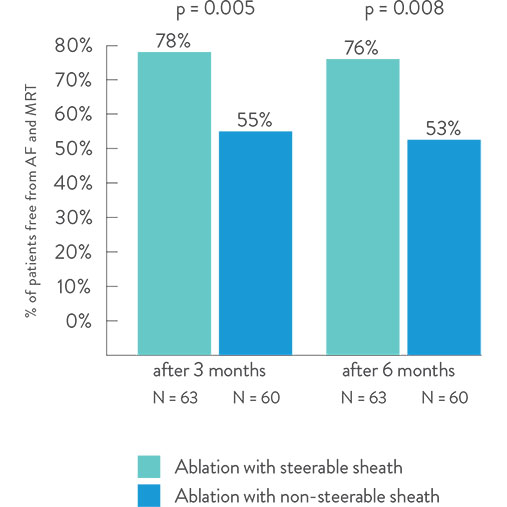
TOCCASTAR Study Highlights: Trial Overview
Exploratory Analysis of Deflectable Sheath Impact3
A retrospective analysis of TOCCASTAR Study data demonstrated the impact of steerable sheath usage during the treatment of atrial fibrillation. Freedom of arrhythmia at 12 months in this 300-patient study was 74% when the ablation catheter was used in conjunction with the Agilis™ NxT Steerable Introducer as compared to 62.7% when a fixed guiding sheath was used.
- Higher average contact force was observed when the Agilis NxT Steerable Introducer was used with the TactiCath™ Ablation Catheter, Sensor Enabled™ (23.3 g vs. 14.6 g with steerable vs. fixed sheath, respectively).
- The Agilis™ NxT Steerable Introducer can help achieve sufficient and stable contact in hard to reach areas (such as in the left anterior pulmonary veins).
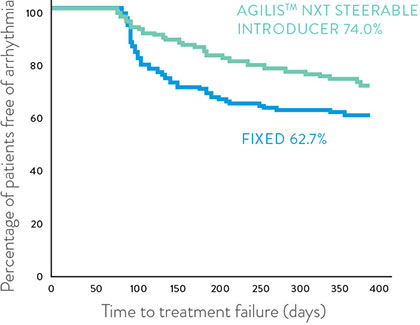
Prospective Randomized Comparison of a Steerable Versus a Non-Steerable Sheath for Typical Atrial Flutter Ablation4
Procedural efficacy improvements were achieved during cavotricuspid isthmus ablation when the ablation catheter* was supported by the Agilis NxT Steerable Introducer versus a fixed guiding introducer.
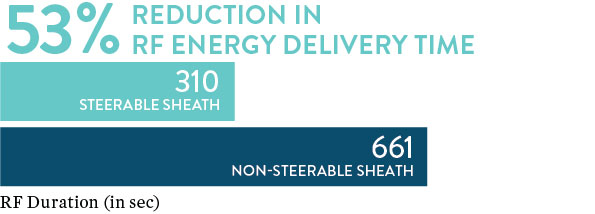
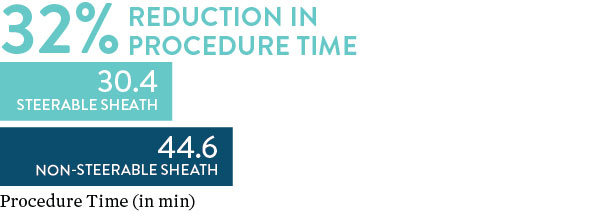
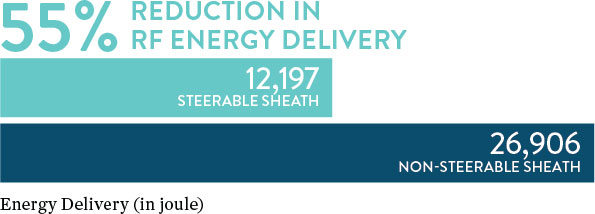
*Ablation catheter used in conjunction with the Agilis NxT Steerable Introducer: Boston Scientific Blazer™ II XP, 8 mm tip.
References
- Kimura, T., Takatsuki, S., Oishi, A., Negishi, M., Kashimura, S., Katsumata, Y., . . . Fukuda, K. (2014). Operator-blinded contact force monitoring during pulmonary vein isolation using conventional and steerable sheaths. International Journal of Cardiology, 177(3), 970-976. https://dx.doi.org/10.1016/j.ijcard.2014.09.189
- Piorkowski, C., Eitel, C., Rolf, S., Bode, K., Sommer, P., Gaspar, T., . . . Hindricks, G. (2011). Steerable Versus Nonsteerable Sheath Technology in Atrial Fibrillation Ablation: A Prospective, Randomized Study. Circulation: Arrhythmia and Electrophysiology, 4(2), 157-165.
- Mansour, M. (2014) TOCCASTAR: Preliminary Results of the First Prospective Randomized Study of a Contact Force Sensing Ablation Catheter for the Treatment of Paroxysmal AF. Presented at HRS 2014. San Francisco, California.
- Matsuo, S., Yamane, T., Tokuda, M., Date, T., Hioki, M., Narui, R., . . . Yoshimura, M. (2010). Prospective randomized comparison of a steerable versus a non-steerable sheath for typical atrial flutter ablation. Europace, 12(3), 402-409.
MAT-2012304 v2.0
